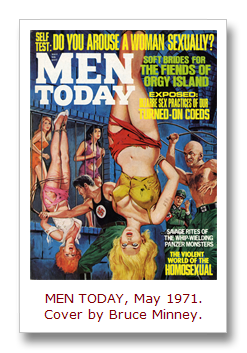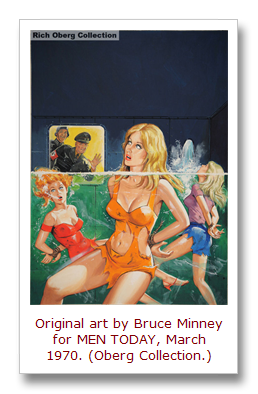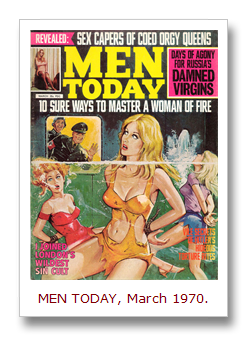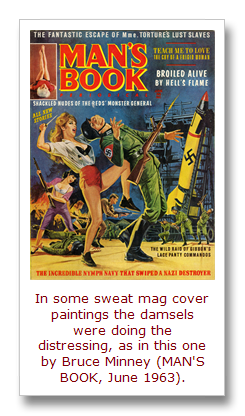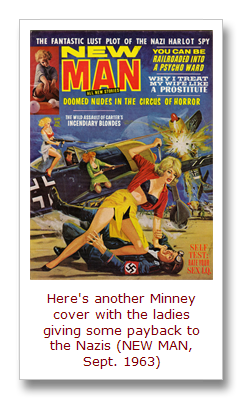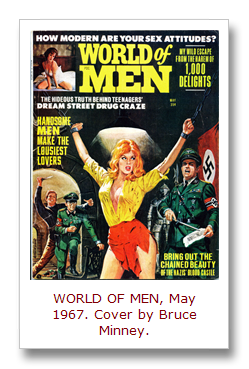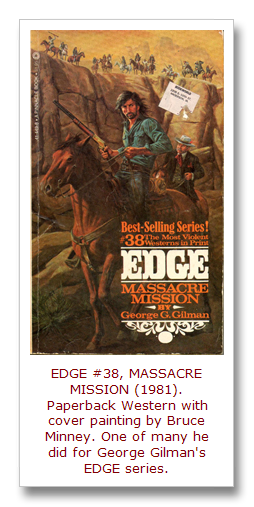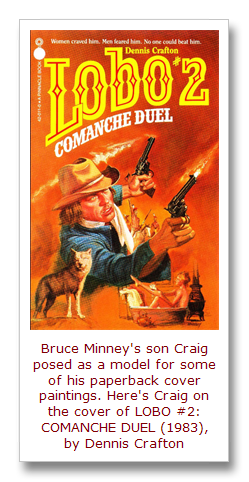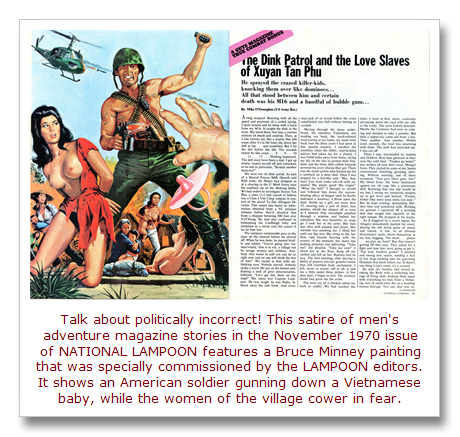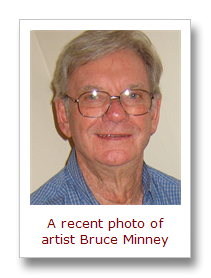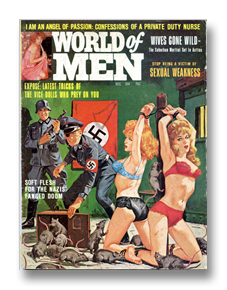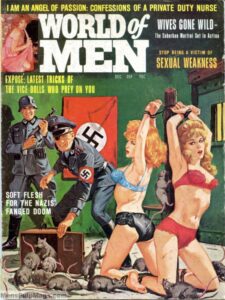
In the first part of my interview with Bruce Minney, he told me how he got started doing cover and interior art for men’s adventure magazines in 1955, after linking up with Magazine Management.
Magazine Management is the umbrella name often used to refer to what was actually a set of companies owned by Martin Goodman, the pioneering publisher who also founded the comic book company that became Marvel Comics.
Mag Management and its associated companies, such as Atlas Magazines, Inc., Vista Publications and Official Magazine Corp., put out a long list of classic men’s pulp mags from the mid-1950s to the mid-1970s.
They included many of the best known, longest lasting men’s adventure magazines, like STAG, FOR MEN ONLY, MALE, MAN’S WORLD and MEN, as well as many lesser known and shorter lived titles like ACTION LIFE, ADVENTURE LIFE, ADVENTURE TRAILS, BATTLEFIELD, COMPLETE MAN, FISHING ADVENTURES, HUNTING ADVENTURES, KEN FOR MEN, MEN IN ACTION, REAL LIFE ADVENTURES, SPORT LIFE, SPORTSMAN, TRUE ACTION and WAR.
Minney was one of a group of talented artists that Magazine Management used on a regular basis in the Fifties, Sixties and Seventies. Those regulars included illustration luminaries like Mort Kunstler, Gil Cohen, James Bama, Charles Copeland, Rudy Nappi, Earl Norem, Samson Pollen, Vic Prezio and Robert Schulz. In the 1960s and early 1970s, Minney also began doing covers for the more lurid “sweat magazine” subgenre.
That’s the subgenre of men’s adventure magazines best known for featuring politically-incorrect bondage and torture cover paintings, particularly “Naziploitation” (aka “Nazisploitation”) style covers showing Nazi soldiers torturing semi-nude damsels in distress or Nazi dominatrix characters torturing American GIs.
Sweat magazines with cover paintings by Bruce Minney, Norm Eastman, John Duillo, Basil Gogos, Norman Saunders, Syd Shores and Vic Prezio are now among the most highly sought men’s adventure magazines among collectors.
In recent bidding battles I’ve seen on eBay, some issues have sold for $150 or more. And, the rare, surviving original paintings used for sweat magazine covers now sell for thousands in art auctions.
In my conversation with Bruce, I asked him how he got started doing sweat mag covers…
BRUCE: Well, sometime in the Sixties I started getting jobs from the publisher who did a lot of the magazines with all the girls tortured by Nazis and stuff like that. I can’t remember the name of that outfit.
I think most of the sweat mag covers you did were for magazines published by Reese Publishing Co. and Emtee Publications, Inc. Reese and Emtee were both owned by B.R. “Bud” Ampolsk and Maurice Rosenfield. Their companies published many of the most famous sweat magazines that had a lot of “Naziploitation” covers, like MAN’S BOOK, MAN’S EPIC, MAN’S STORY, MEN TODAY, NEW MAN, REAL COMBAT and WORLD OF MEN.
BRUCE: Yeah, that’s right. That’s them.
Norm Eastman is particularly known for the cover paintings he did for Reese and Emtee magazines. Did you know Norm?
BRUCE: Yes, I knew Norm Eastman quite well. I used to shoot photos of models up in his apartment sometimes. I also used to have a studio with another artist who did a lot of work for those same magazines, John Duillo. At one point, John and I had a studio where we just shot pictures of models. That’s all we did up there. It was across the street from the Flatiron Building. You know that John’s wife was an illustrator, too, right?
Yes. Elaine Duillo. She’s great. There’s been speculation among collectors of men’s adventure art that Elaine may have painted some of the men’s adventure magazine illustrations that were credited to John.
BRUCE: No, I don’t think she did. She was a top notch illustrator. She was kind of way above that. Oh, wait a minute! [He laughs.] I guess that doesn’t sound good for guys like me and John, does it? Anyway, John used to work for the photographer Robert Scott in the darkroom. That’s where I met him. John used to develop my pictures during my early years as an illustrator, when I was using Scott to take my model photos, before I started doing my own model photography.
Did you meet Norm Eastman through Bud Ampolsk and Maurice Rosenfield?
BRUCE: Yeah, I think I may have first met Norm at their offices. Bud was the guy I dealt with there. One of the things I remember about him is that he once told me he wanted the women I painted to be more “sausage-like.”
Sausage-like?
BRUCE: Yeah, I was doing long, slender women that I thought looked hot. But Bud said he liked them a bit fatter and shorter. He said, “Can you make them look more like sausages?” I said, “Uh, sure.” But I didn’t.
Did you enjoy doing paintings for the Reese and Emtee sweat magazines?
BRUCE: No, I’m not into torture. Sorry.
Hah! OK. Let me put it this way: did you find them to be so over-the-top that they seemed humorous to you then, like they do a lot of people now in retrospect?
BRUCE: No, it was very serious business. We were really torturing those girls. [He chuckles.]
There’s an interview with Norm Eastman in the first edition of the book MEN’S ADVENTURE MAGAZINES [the 2004 softcover edition with the scorpion cover]. In that, Norm said he used to brainstorm torture methods with Bud Ampolsk. Did you do that?
BRUCE: No, I never brainstormed with Bud. I’d just come in and he’d say can you do this or that. He’d give me a situation.
What would he say to describe a scene?
BRUCE: Well, I’m looking at a cover I did for him right now in a book in front of me. It has been attributed to Norm Eastman sometimes, but it’s mine. It’s the one with the rats. The bad guy has a patch over his eye, the Nazi Commander. He’s letting the rats out of the cage, and the girls are tied up to a stake, arms above their heads, and these rats are running around.
Oh yeah, that was used on the cover of the December 1964 issue of WORLD OF MEN. That’s a wild cover painting. How would Bud explain something like to you?
BRUCE: He would just say: “Can you do a Nazi releasing rats with some girls tied to a stake, with their hands over their heads?” So, I did that, and I put a Nazi flag in the back and a guard with a machine gun.
Did you give Bud a sketch before you did a painting for him?
BRUCE: Yes, I did.
How many assignments did Bud give you at a time?
BRUCE: One. Then I’d make some sketches. I’d bring those in and after he OKed them I’d go shoot photos of my models. Then I’d do the paintings at home. I wish I’d kept all of those paintings now.
Yeah, they’d be worth quite a lot today.
BRUCE: I understand some of the Nazi paintings Norm did for Bud sell for ten thousand or more now. Is that right?
Yes, I think that’s true.
BRUCE: [He laughs.] Norm probably got paid $200 or so when he painted one, as I did. For those magazines, $200 was usually tops for a cover painting.
Were interiors less?
BRUCE: Yes, but I never did interiors for those magazines. I was too high class for that. [He laughs again.] Of course, I did do a lot of interiors for the Magazine Management magazines. In fact, in the late Sixties and early Seventies, I was getting a lot of what would have been Mort Kunstler’s jobs, because he had moved on. The scenes with hundreds of figures — battles, a bank robbery in Rome, an escape from a prison. I could do that stuff, too, like Mort, though I wasn’t as fast as Mort was. There’s a funny story about Mort that I heard. Mort is a left-hander. One day he was listening to his mother talking on the phone to one of her friends. And, he heard his mother say to her friend, “Just think of what he could have done if he was right-handed.”
I don’t recall Norm Eastman doing much for the Magazine Management mags.
BRUCE: No, I don’t remember him doing anything for them. I can tell you a funny story about Norm, too. His girlfriend, or maybe it was his wife, was at this apartment building. And, Norm thought it would be funny if he took off all his clothes in the hallway, then knock on the door and she’d open it and he’d be standing there naked. He thought it would be hilarious. But before she answered the door, the people from the adjoining apartment came out and saw him no clothes on. So the joke was on him, or maybe on them. Anyway, that was his story. I don’t know if it was true.
Recently, when I visited my friend Rich Oberg, the men’s pulp art collector, he showed me dozens of terrific men’s adventure paintings by you and Norm that he’s tracked down and bought over the years. He also has some cover paintings Norm did for Harlequin romance paperbacks.
BRUCE: I did some Harlequin covers, too. But I was doing their adventure novels. Norm was originally from Canada, where Harlequin has its offices. I remember the art director for Harlequin came down to visit me in New York once. He knew I lived near a big Playboy Club in New Jersey. He said he wanted to visit me and we were supposed to talk about covers, but he really wanted to go to the Playboy Club. So, I took him up there.
Do you remember how you got hooked up with Harlequin?
BRUCE: I think they saw some of my stuff in the men’s adventure magazines and contacted me.
By the time the men’s adventure mags started to fade away in the 1970s, you were already doing books covers. And, you really did a lot of them in the Seventies and Eighties. Your son-in-law Tom Ziegler told me you created cover paintings for over 400 paperbacks in those years for a long list of companies: Grosset & Dunlap, Avon, Fawcett, Harlequin, Ace, Pinnacle, Manor Books, Pyramid…
BRUCE: Yes, I got into that because I could see the end coming for men’s adventure magazines.
You did covers for several popular paperback series I’m a fan of, like the EDGE Western series by George C. Gilman and the Horatio Hornblower series published by Pinnacle.
BRUCE: Yes, I mostly did covers for Westerns, action and adventure novels, historic novels. Stuff like that. I didn’t do romance covers like Norm did.
I also recall a really wild illustration you did for NATIONAL LAMPOON magazine, the November 1970 issue. It was for a story that spoofed the men’s adventure magazine stories and artwork and also reflected the anti-Vietnam War sentiments of the time.
BRUCE: Yes, I only did that one job for them. It was a very brutal illustration. And, at first, I didn’t know whether I wanted to do that one or not. It shows a GI machine-gunning a baby. You just see the baby’s hand in the foreground dropping the pacifier. There’s a bare-breasted woman next to the GI and some nude woman in the background. And a helicopter.
I’ve seen that one in person at Rich Oberg’s house. He owns the original painting. In the magazine, a banner at the top of the page says it came from “GUTS Magazine,” which is fictitious, but not too different from some of the names actually used for men’s pulp mags. The title of the story is “The Dink Patrol and the Love Slaves of Xuyan Tan Phu.” The illustration you did for it is actually really great.
BRUCE: Yeah, it did turn out to be a great illustration. NATIONAL LAMPOON later put it in a show of the magazine’s artwork that toured all the way to Japan.
Were you still living in New York in 1970?
BRUCE: Yes. We lived there throughout the Seventies. Then in 1981 we moved back to California, because some guy in Los Angeles saw my work and he said I could get movie poster jobs there. And, those really paid big — five or six grand each. My wife Doris and I were both from California and she wanted to go anyway. So, we moved back, but the guy who said he could get me movie poster work didn’t follow through. I didn’t get any work from him. Then my wife died and I went back to UCLA and learned how to do the newer type of illustration art that uses markers because I thought it might help me get some advertising work, which it did. I did a bunch of marker samples and took them around and got jobs from advertising agencies. So, I started doing that, plus painting paperback covers.
Did you move back to Oakland, where you grew up?
BRUCE: No, I moved to near L.A., in Ventura. People told me that was a good area to be in because artists could get work doing storyboards, which I did. Storyboard work was fast paced. You’d go in one day and you’d have to have six illustrations the next morning. I actually did storyboards for a long time. I did some for advertising agencies, for ads for companies like McDonald’s and Chrysler. I also did storyboards for NBC for a long time. But it was all freelance. I never worked at their studios. I always freelanced. I never had a real job.
So in the 80s, you did a combination of things — advertising, storyboards, paperback covers. Did you ever get any movie poster work?
BRUCE: No, I never did.
This is the end of Part 2 of my interview with Bruce Minney. Here’s a link to Part 3.
Be sure to check out the Wikipedia entry about Bruce created by his son-in-law Tom Ziegler.
* * * * * * * * * *
Comments? Corrections? Post them in the Men’s Adventure Magazines Facebook Group.
|



